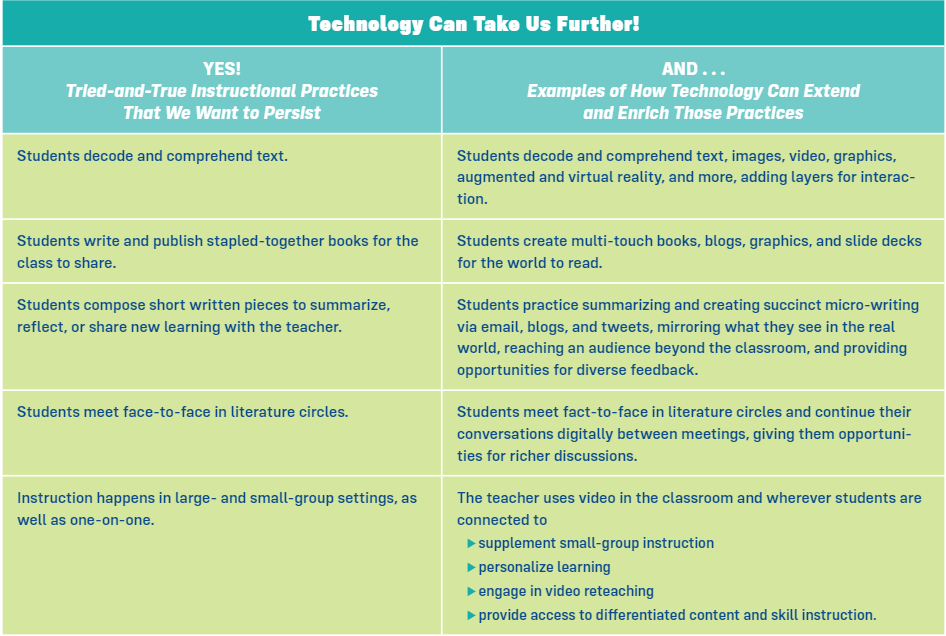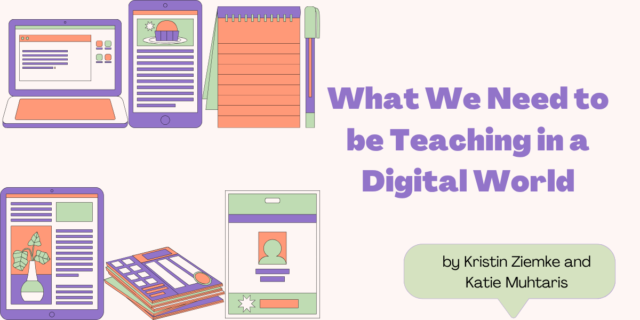
If you’re like every other teacher, you look forward to the day that classrooms return to normal, and with COVID-19 vaccine rolling out, you have hope it can happen this year. As this reality moves closer, you might want to reflect on your experiences with digital instruction and your students’. Would you incorporate digital tools into your in-person teaching? Or more deeply into your teaching?
If you’re like every other teacher, you look forward to the day that classrooms return to normal, and with COVID-19 vaccine rolling out, you have hope it can happen this year. As this reality moves closer, you might want to reflect on your experiences with digital instruction and your students’. Would you incorporate digital tools into your in-person teaching? Or more deeply into your teaching?
In Read the World, Kristin Ziemke and Katie Muhtaris tackle the question of what it means to blend technology with what you already do well. In this excerpt, they identify ways to use technology strategically for in-person instruction. Although written before the pandemic, their advice is not only spot-on but will be a great tool for transferring your learning about online instruction to daily practice.
|
Often, tech in education is put in opposition with “the old way” of doing things. Yet, even though we now have access to some previously unimagined tools (who might have guessed, a decade ago, that it would be common for children to have access to age-appropriate video-editing tools?), our goals for our students are still the same: autonomy, agency, growth, curiosity, joy. Instead of throwing out the approaches that have worked for us in the past, we can say, “Yes, we write stapled-together books, AND we publish slide decks” or “Yes, we paint murals that teach, AND we record a song that summarizes learning” or ”Yes, we have face-to-face book clubs, AND we collaborate online.” Tried-and-true strategies and practices can still be of use, but with the help of technology, we can look beyond the walls of our classroom and give students opportunities that are authentic, significant, and relevant in the world beyond school. In the chart below you’ll see some of the ways technology builds upon the rich pedagogy of literacy instruction to support students. Our work is also about helping our students see technology as a tool to be used strategically. Katie often thinks of the kindergartner who, with the air of an evening anchor delivering breaking news, tugged at Katie’s pant leg, held up her tablet, and said, “Hey, there aren’t any games on here!” It’s common for young children to come to school with the impression that technology is a tool for entertainment. If they have access to Siri, Alexa, Google Home, or other voice-activated technology at home, they might also see technology as a tool to get answers to straightforward questions like “How high can a serval jump?” or “How long does it take for the earth to go around the sun?” But it’s rare that students come to our classrooms already seeing technology as a tool for collaboration and creation, for personal inquiry, or for widening their perspective on the world. Children learn from our example in all ways, including how we use technology and how we allow them to use it. It’s up to us to help students realize the full potential of the tools in their hands, to assist them to find meaningful purposes for those tools, and to learn to walk away from those tools when they’re not helpful or when the tools are becoming harmful to their health or learning.
How Can I Use Technology Strategically and Teach My Students to Do the Same?When planning for technology use, ask yourself:
|
For some the pandemic has led to an overdose of digital teaching. For others it has opened whole new avenues of thinking about instruction. No matter which side of this spectrum you fall on, you’ve probably discovered a favorite digital tool, and Katie and Kristin are here to help you make the most of when we truly go back to school.
 Kristin Ziemke is a teacher, staff developer, and the co-author of Read the World: Rethinking Literacy for Empathy and Action in a Digital Age, Amplify: Digital Teaching and Learning in the K-6 Classroom, and Connecting Comprehension and Technology. Recognized as an international expert in literacy, inquiry, and technology, Kristin collaborates with organizations around the world to develop learning experiences that redefine school. Currently serving as a resident teacher and learning innovation specialist for the Big Shoulders Fund, Kristin has been recognized as an Apple Distinguished Educator, Chicago Public Schools Tech Innovator of the Year, National Board Certified Teacher, and Emerging Leader by the Chicago Council on Global Affairs. Her work has been featured by Apple, EdWeek, Mindshift, and Scholastic.
Kristin Ziemke is a teacher, staff developer, and the co-author of Read the World: Rethinking Literacy for Empathy and Action in a Digital Age, Amplify: Digital Teaching and Learning in the K-6 Classroom, and Connecting Comprehension and Technology. Recognized as an international expert in literacy, inquiry, and technology, Kristin collaborates with organizations around the world to develop learning experiences that redefine school. Currently serving as a resident teacher and learning innovation specialist for the Big Shoulders Fund, Kristin has been recognized as an Apple Distinguished Educator, Chicago Public Schools Tech Innovator of the Year, National Board Certified Teacher, and Emerging Leader by the Chicago Council on Global Affairs. Her work has been featured by Apple, EdWeek, Mindshift, and Scholastic.
 Katie Muhtaris is a co-author of Read the World: Rethinking Literacy for Empathy and Action in a Digital Age, Amplify: Digital Teaching and Learning in the K-6 Classroom, and Connecting Comprehension and Technology. She currently works with kindergarten through fifth grade as an Instructional Digital Age Learning Coach, supporting teachers and students in the areas of literacy, humanities, and technology. As an experienced educator in both urban and suburban settings, Katie consults with districts to implement innovative instructional practices with a close eye on student impact. Katie is an internationally recognized expert in technology and workshop model integration. Katie works with districts to develop innovative learning experiences for teachers and students that merge the best of print and digital resources and tools. Her other areas of interest include inquiry based instructional models, integrated social emotional practices, and building cultures of support and risk taking among teachers.
Katie Muhtaris is a co-author of Read the World: Rethinking Literacy for Empathy and Action in a Digital Age, Amplify: Digital Teaching and Learning in the K-6 Classroom, and Connecting Comprehension and Technology. She currently works with kindergarten through fifth grade as an Instructional Digital Age Learning Coach, supporting teachers and students in the areas of literacy, humanities, and technology. As an experienced educator in both urban and suburban settings, Katie consults with districts to implement innovative instructional practices with a close eye on student impact. Katie is an internationally recognized expert in technology and workshop model integration. Katie works with districts to develop innovative learning experiences for teachers and students that merge the best of print and digital resources and tools. Her other areas of interest include inquiry based instructional models, integrated social emotional practices, and building cultures of support and risk taking among teachers.
You can connect with Katie on Twitter @KatieMuhtaris



